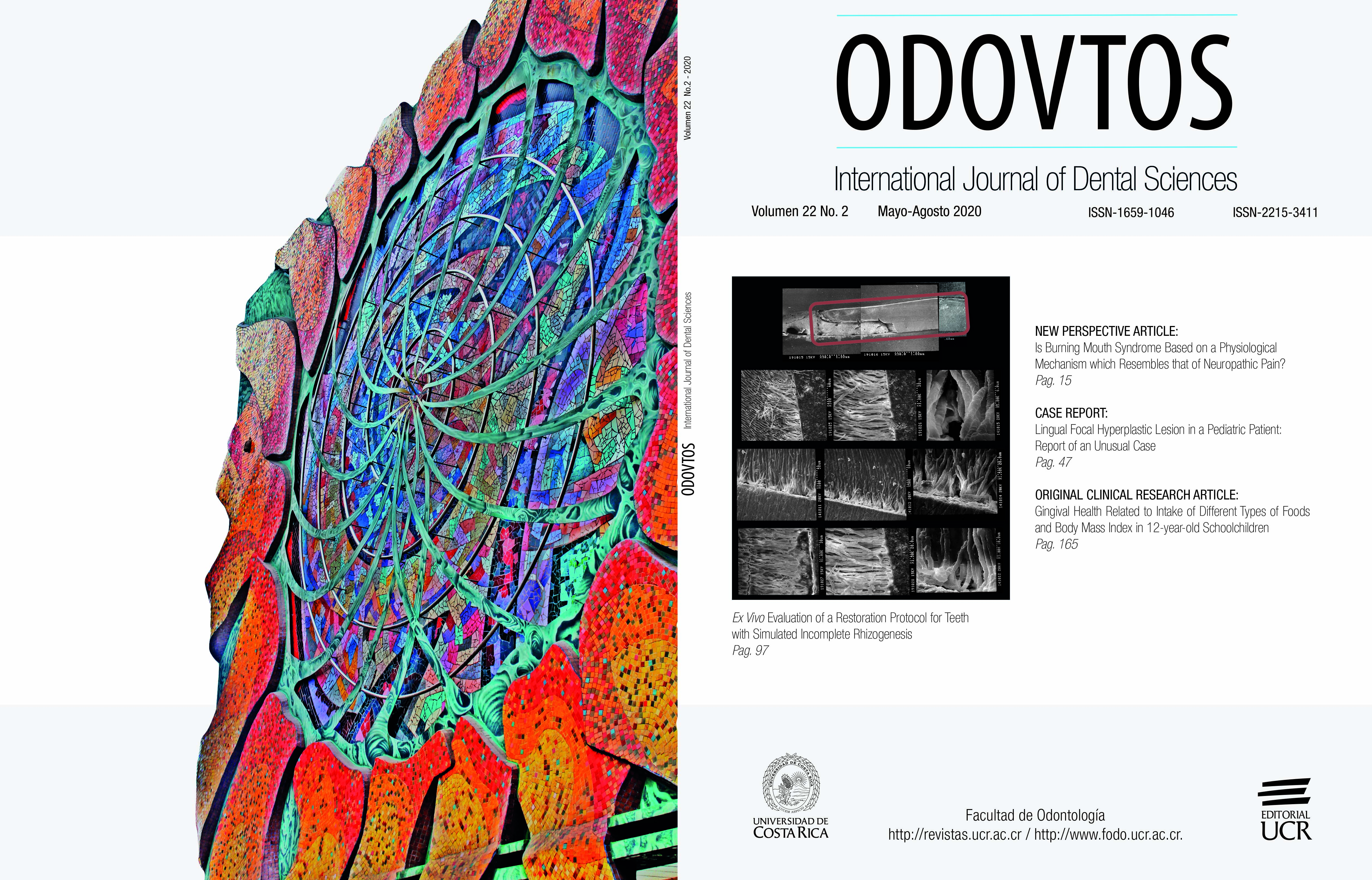Resumen
El síndrome de la boca ardiente (SBA) es un estado crónico de dolor intraoral descrito por pacientes como dolor o sensación quemante, de cosquilleo o adormecimiento de la mucosa oral, con ausencia de lesiones visibles en la boca. Puede afectar la lengua, el paladar anterior y o los labios. Su diagnóstico es basado en la típica descripción subjetiva del paciente, excluyendo cualquier otro factor sistémico o local que podría provocar cualquier otra sensación quemante dentro de la mucosa oral. Estudios relevantes han mostrado que SBA primario parece tener una patofisiología de origen de tipo neuropático donde pacientes con SBA pueden presentar distintas anormalidades en el complejo trigeminal a nivel de las fibras sensoriales delgadas y gruesas. Por tanto, el tratamiento y manejo de estos pacientes debe ser de la misma manera multidisciplinaria como en el caso con el dolor neuropático, sin olvidar incluir el manejo de todos los factores que podrían intervenir en la etiología del SBA.
Citas
Grushka M. Clinical features of burning mouth syndrome. Oral Surg Oral Med Oral Pathology 1987; 63 (1): 30-36.
Ship J.A., Grushka M., Lipton J.A., Mott A.E., Sessle B.J., Dionne R.A. Burning mouth syndrome: an update. J Am Dent Assoc 1995; 126 (7): 842-8533.
Jääskeläinen S.K. Pathophysiology of primary burning mouth syndrome. Clin Neurophysiol. 2012; 123 (1): 71-77.
Mock D. and Chugh D.Burning Mouth Syndrome. Int J Oral Sci. 2010; 2 (1): 1-4.
Granot M., Nagler R.M.Association between regional idiopathic neuropathy and salivary involvement as the possible mechanism for oral sensory complaints. J Pain 2005; 6 (9): 581-587.
Eliav E., Kamran B., Schaham R., Czerninski R., Gracely R.H., Benoliel R. Evidence of chorda tympani dysfunction in patients with burning mouth syndrome. J Am Dent Assoc.2007; 138 (5): 628-633.
International Headache Society. The International Classification of Headache Disorders: 2nd edition. Cephalalgia. 2004; 24 (1): 133.
Woda A., Pionchon P. A unified concept of idiopathic orofacial pain: clinical features. J Orofacial Pain 1999; 13 (3): 172-84.
Scala A., Checchi L., Montevecchi M., Marini I., Giamberardino M.A. Update on burning mouth syndrome: overview and patient management.Crit Rev Oral Biol Med 2003; 14 (4): 275-291.
Zakrzewska J.M., Forssel H., Glenny A.M. Interventions for the treatment of burning mouth syndrome. The Cochrane Database of Systematic reviews. 2005; (1) 12.
Braud A., Toure B., Agbo-Godeau S., Descroix V., Boucher Y. Characteristics of pain assessed with visual analog scale and questionnaire in burning mouth syndrome patients: a pilot study. J Orofac 2013; 27 (3): 235-242.
Jääskeläinen S.K., Forssell H., Tenovuo O. Abnormalities of the blink reflex in burning mouth syndrome. Pain 1997; 73 (3): 455-460.
Forssell H., Jääskeläinen S.K., Tenovuo O., Hinkka S.Sensory dysfunction in burning mouth syndrome. Pain 2002, 99 (1-2): 41-47.
Lauria G., Majorana A., Borgna M., Lombardi R., Penza P., Padovani A., Sapelli P. Trigeminal small-fiber sensory neuropathy causes burning mouth syndrome. Pain 2005; 115 (3): 332-337.
Borelli V., Marchioli A., Di Taranto R., Romano M., Chiandussi S., Di Lenarda R., Biasotto M., Zabucchi G. Neuropeptides in saliva of subjects with burning mouth syndrome: a pilot study. Oral Dis 2010; 16 (40): 365-374.
Puhakka A., Forssell H., Soinila S., Laine M., J. Jaaskelainen. Burning mouth syndrome: a peripheral small fiber neuropathy. Clin Neurophysiol 2010; 121 (1) S230.
Treede R.D., Jensen T.S., Campbell J.N., Cruccu G., Dostrovsky J., Griffin J.W., Hansson P., Hughes R., NurmikkoT., Serra J. Neuropathic pain: redefinition and a grading system for clinical and research purposes. Neurology. 2008; 70 (18): 163-165.
Grushka M., Sessle B.J., Howley T.P. Psychophysical assessment of tactile, pain and the thermol sensory functions in burning mouth syndrome. Pain 1987; 28 (2): 169-184.
Svensson P., Bjerring P., Arendt-Nielsen L., Kaaber S. Sensory and pain threshold to orofacial argon laser stimulation in patients with chronic burning mouth syndrome.Clin J Pain 1993; 9 (3): 207-215.
Gremeau-Richard C., Dubray C., Aublet-Cuvelier B., Ughetto S., Woda A. Effect of lingual nerve block on burning mouth syndrome (stomatodynia): a randomized crossover trial. Pain 2010; 149 (1): 27-32.22.
Beneng K., Renton T., Yilmaz Z., Yiangou Y., Anand P. Sodium Channel Nav 1.7 immunoreactivity in painful human dental pulp and burning mouth syndrome.BMC Neurosci 2010; 8 (11) 1171.
Yilmaz Z., Renton T., Yiangou Y., Zakrzewska J., Chessell I.P., Bountra C., Anand P. Burning mouth syndrome as a trigeminal small fiber neuropathy: increased heat and capsaicin receptor TRPV1 in nerve fibers correlates with pain score. J Clin Neurosci 2007; 14(9): 864-71.
Sessle B. J. (ed) Orofacial Pain.Recent Advances in assessment,management,and understanding of mechanisms.Washington, D.C: IASP Press. 2014; pag 430.

